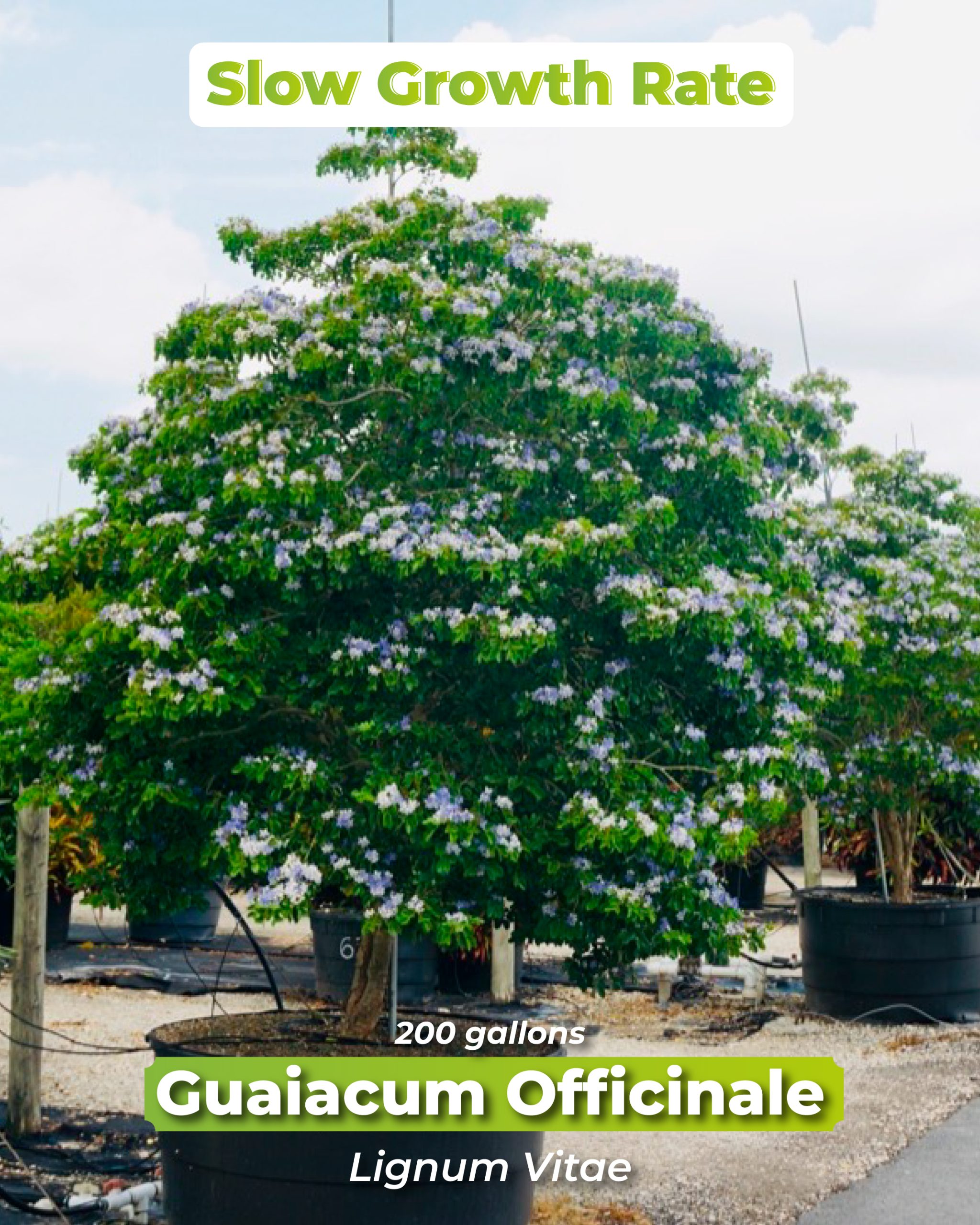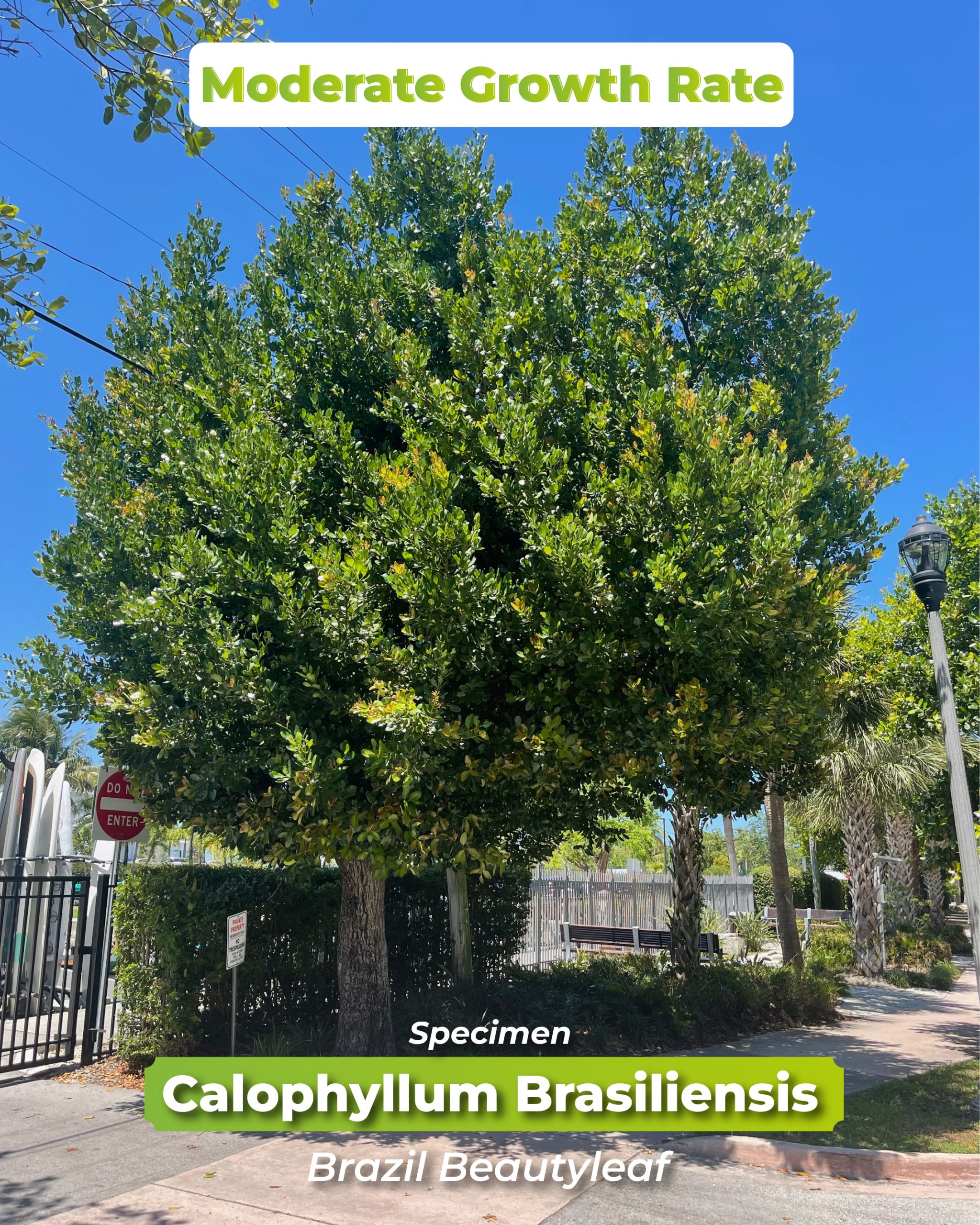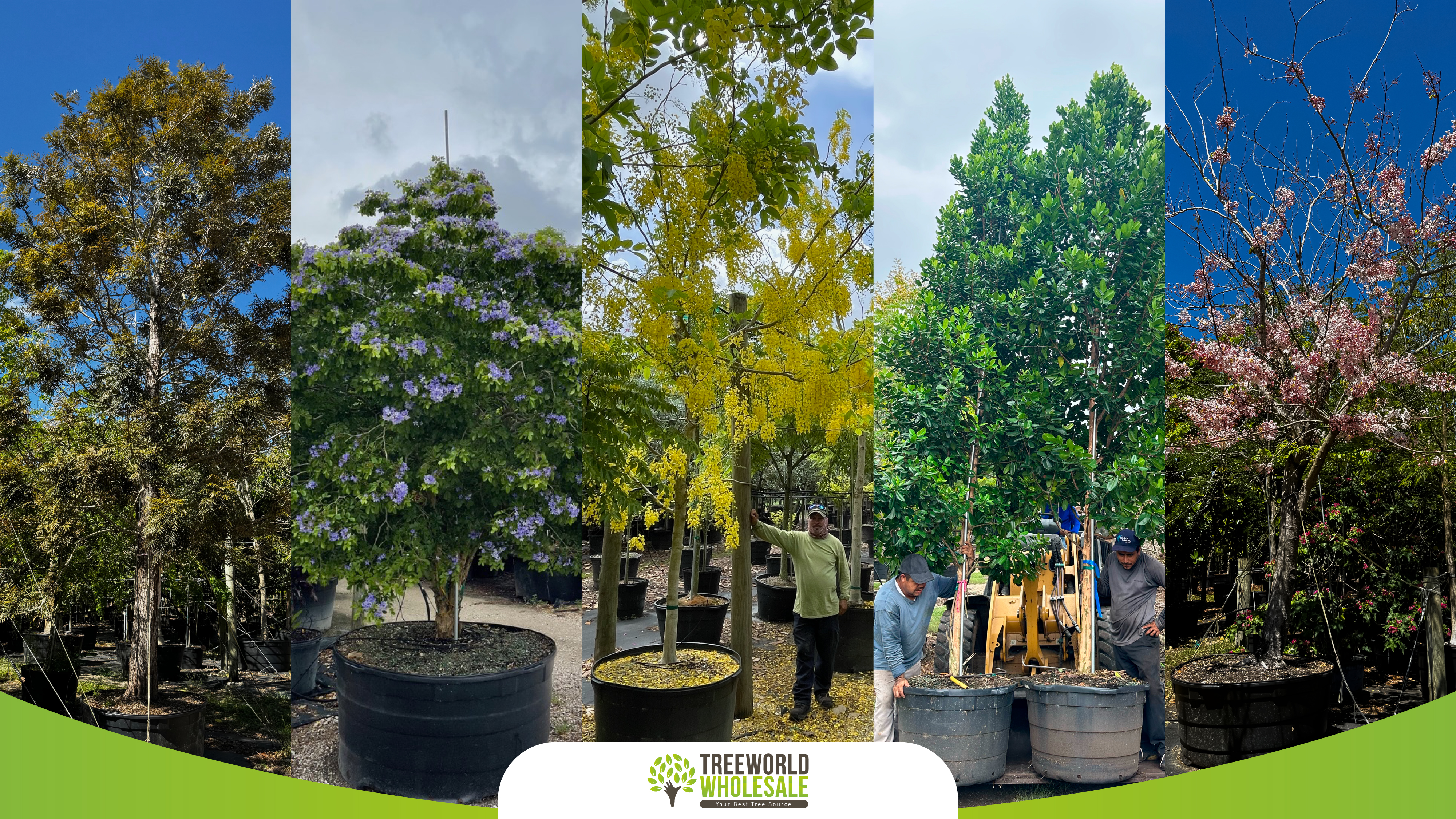When you’re in the process of buying a tree, it might be intuitive to think that the size of the container directly dictates the quality or specifications of the tree. However, in our business, we urge you to look beyond the container. Here’s why!
Not all trees grow the same, and at the same time. It is important to understand that each tree has its own unique growth pattern, and in TreeWorld, as in nature, there’s a vast diversity of trees. In our case, we have over 300+ varieties we deeply care for, and we go the extra mile to provide the best growing conditions.
Tree Growth Rate
Having said that, it’s important to analyze how growth rates differ between species. For instance, the Guaiacum officinale, commonly known as Lignum Vitae or “tree of life,” is a slow-growing tree. It’s one of the most well-known species from the Guaiacum genus and is notable for its extremely hard and dense wood. It grows slowly, often taking many years to reach maturity.
Slow Growth Rate Trees
With the tree of life, we have one of our all-stars at the nursery. We take immense pride and care in our tree farm nurseries in Homestead. Overseeing everything from the seed through the full growing process. If you’ve ever visited our nursery, you’ve witnessed the magic of our Guaiacum Officinale tree rows. With immense love and dedication, we nurture them, ensuring they receive well-drained soils, appropriate watering tailored to the tree’s stage, and the right amount of light for them to thrive.
Ultimately, they grow into our standard size containers, starting at 25 gallons, and for this particular tree, they can even expand to 300 gallons according to our standards.
Fast Growth Rate Trees
On the other hand, we have fast-growing trees. A popular group is the ‘Cassias’, which are beautiful ornamental flowering trees. Growing several feet per year under the right conditions. Nonetheless, this is a keyword as we address the subject, given that Cassias thrive best in full sun and well-draining soil. While they’re moderately drought-tolerant after establishment. Regular watering during their initial growth is beneficial. Occasional pruning after the flowering period helps maintain their shape, and while they’re generally, pest-resistant, regular inspection is wise, especially during early stages.
Moderate Growth Rate Trees
Another tree growth rate that can mark the pace is a moderate rate, like the Calophyllum Brasiliensis, best known as the Brazil Beautyleaf, native to Central and South America. It’s a high-performance tree that requires understanding its native habitat and ensuring that its basic needs are met. Especially when grown outside its natural range.
Specifically, Calophyllum Brasiliensis thrives in well-draining soils. In early stages, it’s crucial to ensure the tree receives adequate watering. Once established, it can tolerate periods of water stress but will benefit from regular watering in extended dry periods. For optimal growth, it prefers full sunlight, and given its expansive canopy, proper spacing is essential to ensure quality growth.
Having said that, in a tree farm nursery like ours, it’s important to understand each species. This is one of the reasons you can’t determine a tree’s worth by the container. Trees are natural beings, and we take measures to guarantee healthy growth. Tree specifications matter; it’s not only about fitting into the container. The tree’s health, strength, and adaptability speak volumes.
Specifications Vary!
While two trees may be in a similar gallon size container, the maturity of the tree may not be the same. For example, one might have stronger roots, a sturdier trunk, or more developed branches than the other. That’s why our focus is on the tree’s specifications, not the size of the container it comes in. And as tempting as it is to judge a tree’s value solely based on the size of its container, it’s a misleading metric.
And while two trees may be housed in the same gallon size container, their actual maturity and health can differ vastly. One tree might boast a complex and robust root system, ready to anchor itself securely in any landscape. In contrast, another might have invested its energy into developing a sturdy trunk or spreading its branches wide, preparing itself for a future as a canopy giant.
Tree Growth Rates by Species – Same Size, Different Value
Nonetheless, here’s a quick example. We have two excellent hedge material trees, but they vary in prices. On one hand, the top performer Bayrum Tree (Pimenta Racemosa) and on the other side we have a great native tree, the Red Stopper Eugenia Rhombea. Both species are great for hedges in the South Florida landscape, but they are priced differently. Here’s a closer look into what might contribute to their distinct valuations.
Bayrum tree (Pimenta Racemosa)
One of the factors that contribute to the popularity of certain trees is their care requirements and applications in landscaping. Take, for instance, the Bayrum tree, which generally has a moderate to fast growth rate. It thrives in tropical to subtropical climates and necessitates well-draining soil. Moreover, it’s a top-performing tree, robustly resistant to strong winds and perfectly resilient to Florida’s varied climate conditions. Its columnar growth habit is a unique trait. Making it an ideal choice for narrow spaces where a dense privacy hedge is desired.
Given its many uses, landscapers often show a greater preference for mature, well-maintained Bayrum trees, not only for their practical advantages but also for their aesthetic attributes. These trees have glossy green leaves, delicate white flowers, and attractive black berries, enhancing the overall appeal of any landscape setting.
Red Stopper (Eugenia Rhombea)
On the Eugenia Rhombea is a compact tree that typically reaches an approximate height of 15 to 20 feet while forming an attractive, moderately dense, and oval crown that spreads out gracefully, featuring leaves with a unique diamond-shaped (rhombic) appearance. Young leaves have a reddish hue, while mature leaves develop a faint yellow edge.
The Reds stopper is known for its low-maintenance qualities, once established. It is drought-tolerant and grows well in both partial shade and full sun. It can withstand salt spray, which makes it a great choice for coastal landscaping.
In conclusion, the price tags on tree species can vary significantly due to numerous factors. Each tree’s growth rate, adaptability, are requirements, and aesthetic and practical applications in landscaping can influence its value. Furthermore, specific traits such as resistance to conditions, flowering patterns, and fruit-bearing capabilities can also play pivotal roles.
TreeWorld’s High-Quality Standard
Furthermore, our commitment is to provide you with the best tree, regardless of its container size. By basing our prices on the tree’s specifications and quality instead of the container. We ensure you get maximum value for your investment. You might be surprised to find that a tree in a smaller container has more desirable features than one in a larger container. This could be because of its genetics, how it has been nurtured, or a range of other factors not directly tied to the container’s size.
In conclusion, when looking for the perfect tree for your project, it’s crucial to look beyond the price tag when selecting a tree, as trees are a long-term investment. In our business and at TreeWorld, we’re committed to helping you understand and appreciate the true qualities and specifications. That make a tree special. Remember, not all trees grow the same, but each has its unique value to offer!
Do you want to know more? On our blog, you can also read about the life cycle of a tree.















